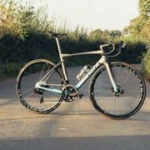Choosing the right mountain bike can be a game-changer for your trail adventures. Whether you’re a seasoned rider or just starting out, having a Recommended Mountain Bike that suits your riding style and terrain is crucial for an enjoyable and efficient experience. At usabikers.net, our expert team has rigorously tested a wide range of trail bikes to bring you this curated guide to the best overall trail bikes available right now. We’ve pushed these bikes to their limits on diverse terrains, from challenging climbs to thrilling descents, to provide you with unbiased and helpful recommendations.
Best Overall Recommended Mountain Bike
Specialized Stumpjumper 15 Comp
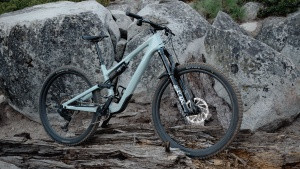 Specialized Stumpjumper 15 Comp trail mountain bike showcasing its frame and suspension system
Specialized Stumpjumper 15 Comp trail mountain bike showcasing its frame and suspension system
OVERALL SCORE: 86
- Fun Factor: 9.0
- Downhill Performance: 9.0
- Climbing Performance: 8.0
- Ease of Maintenance: 8.0
Measured Weight: 32 lbs 9 oz (S4) | Rear Travel: 145mm
REASONS TO BUY
- Adjustable headtube and bottom bracket height for customized geometry.
- Innovative SWAT box for on-bike storage.
- Advanced GENIE Shock technology for enhanced suspension performance.
REASONS TO AVOID
- Only an incremental upgrade from the previous Stumpjumper EVO model.
- Rear brake rotor size might be excessive for some trail riding scenarios.
- Considered heavy for a carbon trail bike in its category.
The Specialized Stumpjumper 15 Comp is a top recommended mountain bike that refines an already exceptional platform. While it may feel like an iterative update, much like a new smartphone model, the Stumpjumper 15 Comp delivers outstanding performance on the trails. Its FACT 11m carbon frame, offering 145mm of travel via a 4-bar linkage, provides adjustable geometry through the headset and chain stays, an updated SWAT box for integrated storage, and clean aesthetics with no routing for mechanical derailleurs. Despite the evolutionary nature of the updates, this bike stands as one of the best trail bikes we have ever tested.
The standout feature of the Stumpjumper 15 is the GENIE shock, a novel air shock design that offers a more linear initial stroke and improved traction. While Specialized’s data highlights the GENIE’s advantages, it’s important to note that it doesn’t fully replicate the feel of a coil shock. Specialized offers a wide range of Stumpjumper models, including coil shock and alloy frame options. The Comp model, positioned as the most affordable carbon variant, features SRAM’s new S1000 Transmission drivetrain, which is undeniably impressive but contributes to the bike’s overall weight.
On the trail, the Stumpjumper 15 is responsive and agile, particularly in steeper geometry settings. It accelerates quickly and inspires confidence across various terrains. In its slackest configuration, with a 63.5-degree headtube angle and a bottom bracket as low as 330mm, it fearlessly tackles steep and challenging terrain. From bike park laps to relaxed XC trails, the Stumpy feels perfectly at home. The new symmetrical front triangle enhances torsional rigidity, providing excellent composure at high speeds and during aggressive riding. The GENIE shock enhances traction, and the relatively steep seat tube angle (76.7 – 75.8 degrees) contributes to efficient and vigorous climbing.
Our primary concern with the Stumpjumper 15 is the inclusion of a native 203mm rear brake mount. When paired with Maven Bronze brakes, this combination can deliver more rear braking power than typically desired on a trail bike.
Read more: Specialized Stumpjumper 15 Comp Review
The Specialized Stumpjumper 15 Comp earns its place as a highly recommended mountain bike due to its versatility and well-rounded performance, making it our top choice for an overall trail bike.
Credit: GearLab Staff
Best Aggressive Recommended Mountain Bike
Ibis Ripmo V2 XT
OVERALL SCORE: 89
- Fun Factor: 9.0
- Downhill Performance: 9.0
- Climbing Performance: 9.0
- Ease of Maintenance: 7.0
Wheel Size: 29-inch | Rear Travel: 147mm
REASONS TO BUY
- Exceptional all-around performance and balance.
- Confident and stable descender.
- Efficient and capable climber.
REASONS TO AVOID
- Not among the lightest bikes in its class.
- Can be considered expensive for some budgets.
The Ibis Ripmo V2 XT is a strongly recommended mountain bike that truly impressed us with its exceptional blend of climbing and descending capabilities. This bike stands out as the best aggressive trail bike we’ve ever tested, solidifying its place in MTB history as a legendary bike that pushes the boundaries of the sport. The updated geometry makes it slightly slacker (64.9-degree head angle) and longer (1238mm wheelbase) than its predecessor, and the suspension kinematics have been refined to be more progressive towards the end of its travel. Already a confident descender, the Ripmo V2 now feels even more composed and planted in challenging terrain. Its combination of high-speed stability and big-hit performance makes it feel fearless on the trails. Few bikes can rival the Ripmo’s capabilities; while the Santa Cruz Hightower is exceptional, it doesn’t quite match the Ripmo’s high-speed confidence and bravado. Both bikes offer excellent deep-stroke compliance, but the Ripmo edges ahead in overall performance. The Ripmo’s 435mm chainstays keep the rear end tight and responsive, contributing to its sporty and agile handling. Its handling can be described as lively and energetic, with a precise and responsive feel. The Ripmo climbs exceptionally well, thanks to its efficient DW-Link suspension platform, steep seat tube angle, and well-engineered kinematics. The term “quiver killer” is genuinely fitting for the Ripmo, as it is one bike that excels in almost all riding disciplines.
The Ripmo V2 is a remarkably balanced and aggressive trail bike, offering a fantastic combination of uphill and downhill prowess. It is ideally suited for riders who prioritize climbing but don’t want to compromise on downhill performance. This bike is a true engineering marvel, and we enthusiastically recommend it. Riders seeking a more budget-friendly option should consider the aluminum-framed Ibis Ripmo AF NX.
Read more: Ibis Ripmo V2 XT Review
The Ripmo V2 demonstrates exceptional capability in handling technical climbs.
Credit: Laura Casner
Best Mid-Travel Recommended Mountain Bike
Revel Rascal XO Transmission
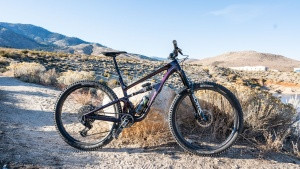 Revel Rascal XO Transmission mid-travel trail mountain bike in action
Revel Rascal XO Transmission mid-travel trail mountain bike in action
OVERALL SCORE: 88
- Fun Factor: 10.0
- Downhill Performance: 9.0
- Climbing Performance: 8.0
- Ease of Maintenance: 7.0
Wheel Size: 29-inch | Rear Travel: 130mm
REASONS TO BUY
- Versatile “go-anywhere” capability.
- Sublime CBF suspension system for excellent traction and control.
- Fantastic wheelset enhancing overall ride quality.
REASONS TO AVOID
- Higher price point compared to some competitors.
- Geometry is not adjustable, limiting customization.
The Revel Rascal XO Transmission is an incredibly capable bike that truly punches above its weight class, making it a highly recommended mountain bike in the mid-travel category. It utilizes the Canfield Brothers Formula (CBF) suspension and cutting-edge thermoset carbon technology to deliver exceptional performance. The geometry provides a playful and responsive feel, while the 130mm of travel allows you to push the limits of what a mid-travel bike can handle. The bike’s dimensions strike a balance, making it versatile without sacrificing its lively and agile character. With a 436mm rear center and a 1222mm wheelbase, the Rascal offers phenomenal traction, whether climbing through rooty sections or braking through rough terrain. Testers noted its resemblance to the Trek Top Fuel 9.8 GX AXS in terms of dialed geometry and kinematics, despite differing dimensions. Both bikes exhibit outstanding ride quality that surpasses expectations based on their specifications. Seasoned riders will be particularly impressed by the suspension’s isolation from rider input. The SRAM XO Transmission build, combined with Revel RW30 Carbon wheels, leaves little to be desired, featuring top-tier RockShox suspension and a robust drivetrain.
While it lacks frame storage and adjustable geometry, these omissions are easily overlooked given its exceptional performance. Although adjustable geometry can enhance versatility, the Rascal’s inherent versatility is undeniable. It excels on trails that might be considered “a bit too much” for other bikes in its travel category, yet it never feels like overkill on mellow XC trails. For performance-oriented riders seeking a no-compromise trail bike, the Rascal is an excellent choice, backed by Revel’s guarantee. Despite testing numerous expensive mountain bikes annually, the Rascal stands out as a truly exceptional bike that justifies its premium price tag. We hope to see a more affordable version of this bike in the future without sacrificing its inherent magic.
Read more: Revel Rascal XO Transmission Review
The Revel Rascal is a spectacularly executed recommended mountain bike, blending performance and style into a mischievously fun trail companion.
Credit: Matt Lighthart
Best Technical Recommended Trail Bike
Yeti SB140 LR T2 TURQ
OVERALL SCORE: 86
- Fun Factor: 9.0
- Downhill Performance: 8.0
- Climbing Performance: 9.0
- Ease of Maintenance: 8.0
Wheel Size: 29-inch | Rear Travel: 140mm
REASONS TO BUY
- Phenomenal traction for confident riding.
- Precise and responsive handling.
- Fun and engaging on a wide variety of trails.
REASONS TO AVOID
- High cost, reflecting premium components and brand.
- Geometry is not adjustable, limiting customization.
- Lacks in-frame storage options.
The Yeti SB 140 is a top-tier mid-travel trail bike that offers a precise and efficient ride, making it a highly recommended mountain bike for technical trails. This 140mm 29er delivers exceptional ride quality and performance that goes beyond its geometry numbers. Whether tackling steep climbs, fast flow trails, high alpine epics, or jump lines, the SB140 is ready for the challenge. With excellent climbing traction and near-ideal rider positioning, its long 440mm chainstays keep the rear wheel planted on technical terrain and challenging ascents. The Yeti is equally impressive on descents, maintaining excellent small bump sensitivity throughout its travel, even with a 65-degree headtube angle that provides a spry and agile feel. We appreciated the Yeti’s well-balanced feel and precise tracking. The SB140 inspires confidence in most terrain, only reaching its speed limit in the steepest and most extreme conditions. While still capable of aggressive riding, this bike feels more refined and composed, akin to off-roading in a Range Rover.
If you’re seeking frame storage or adjustable geometry in a new trail bike, the SB140 may not meet those specific needs. Similarly, more aggressive riders might prefer longer-travel, slacker bikes. However, the Yeti offers agility and athleticism, relying less on excessive travel and mass. Its exceptional traction allows you to push cornering and braking limits, making it an ideal companion for tackling the majority of singletrack terrain in North America. Hop on a Yeti SB140 and experience how deftly it handles trail riding duties. For riders seeking something more rowdy, consider the Ibis Ripmo V2 XT or Specialized Stumpjumper 15 Comp.
Read more: Yeti SB140 LR T2 TURQ Review
The Yeti SB140 is accurately and adeptly characterized as a highly recommended mountain bike. While not the biggest or most extreme bike, its capabilities are incredibly impressive.
Credit: Abriah Wofford
Best Short Travel Recommended Trail Bike
Trek Top Fuel 9.8 GX AXS
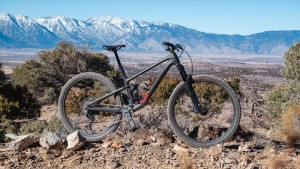 Trek Top Fuel 9.8 GX AXS short travel trail mountain bike in action
Trek Top Fuel 9.8 GX AXS short travel trail mountain bike in action
OVERALL SCORE: 83
- Fun Factor: 8.0
- Downhill Performance: 8.0
- Climbing Performance: 9.0
- Ease of Maintenance: 7.0
Measured Weight: 29 lbs 9 oz (large) | Rear Travel: 120mm
REASONS TO BUY
- Mino-Link system provides adjustable geometry and leverage rate.
- BITS bag integrated downtube storage solution.
- Compatible with 130/140mm suspension fork upgrades.
- Mullet (MX) wheel configuration compatibility.
REASONS TO AVOID
- Wheelset is heavier than desired for optimal performance.
- Short saddle design may not be comfortable for all riders.
The latest generation of the Trek Top Fuel 9.8 GX AXS is a highly recommended mountain bike that delivers modern geometry and smart updates in a short-travel package. Now classified as a “down-country” bike, this 120mm OCLV carbon trail bike is surprisingly capable. It excels on ascents, rivaling modern XC bikes with its quick, responsive handling and efficient pedaling platform. Nimble and quick handling is enhanced by a 76.3-degree seat tube angle, optimizing pedaling power even on steep climbs.
Descending capability is improved by the ABP suspension, which isolates braking forces from the suspension. A 65.9-degree headtube angle slows the steering for rowdier terrain without compromising its exceptional climbing performance. A 1227mm wheelbase provides stability and a higher speed threshold than expected for a short-travel bike. During testing, the “short travel” designation felt like an understatement; the Top Fuel possesses flow, finesse, and true trail pedigree.
A clever 4-way Mino-Link allows for geometry and leverage rate adjustments, and Trek has made the bike compatible with longer shocks and forks, enabling 130/140mm travel setups. Larger wheel sizes are fitted to M, ML, L, and XL models, while the S size gets 27.5″ wheels; all are mullet (MX) compatible. Frame storage via the Bontrager BITS system keeps essential tools organized and quiet.
The Top Fuel is a well-balanced trail bike with significant adjustability, challenging the notion that trail bikes require excessive travel. Trek’s confidence in the bike is reflected in its 30-day Unconditional Guarantee.
Read more: Trek Top Fuel 9.8 GX AXS Review
The Trek Top Fuel proves that short travel doesn’t mean short on fun, making it a recommended mountain bike for its versatility and engaging ride.
Credit: Matt Lighthart
Best Trail Bike Under $3000 – Highly Recommended
Ibis Ripmo AF NX Eagle
OVERALL SCORE: 80
- Fun Factor: 8.0
- Downhill Performance: 9.0
- Climbing Performance: 7.0
- Ease of Maintenance: 7.0
Wheel Size: 29-inch | Rear Travel: 147mm
REASONS TO BUY
- Progressive and aggressive geometry for confident riding.
- Exceptionally confident descender.
- Adept and capable climber for its category.
REASONS TO AVOID
- Heavy aluminum frame construction (AF – Aluminum Frame).
- Sits at the upper end of the budget price range.
The Ibis Ripmo AF is a standout recommended mountain bike for riders seeking exceptional trail performance under $3000. It emerges as an absolute powerhouse of a trail bike that manages to blend trail finesse with impressive climbing ability. The 147mm of DW-Link travel and updated kinematics provide a bottomless feel without the sluggishness often associated with long-travel bikes. The Ripmo’s ride is lively, energetic, playful, and fun, encouraging riders to push their limits. A 160mm fork paired with a 64.9-degree headtube angle makes the Ripmo excel at rapid descents, especially on steeper trails. Yet, with its 76-degree seat tube, this bike remains an adept climber, performing as well as a 34lb trail bike can. The bike exemplifies how well-dialed geometry can enhance rider capability. Ibis has done an excellent job with the component spec, including robust suspension, wide rims, capable tires, and a reliable drivetrain. 4-piston brakes and a long dropper post further enhance its capabilities and inspire confidence. The carbon version of this bike is our Editors’ Choice, utilizing the same platform but with lighter, more premium components.
The main drawback of the Ripmo AF is its weight. At 34 pounds, it can feel substantial when maneuvering through the woods. The weight is further amplified by suspension that lacks advanced valving for enhanced efficiency. It’s also a relatively long-travel bike, which, while providing incredible capability, might be more bike than some riders require. However, the Ripmo feels confidence-inspiring, surprisingly affordable for its performance, and incredibly fun.
Read more: Ibis Ripmo AF Review
Heavy metal performance! The Ripmo AF absolutely rips on the trails, though it is not the lightest bike for ripping around. You’ll be hard-pressed to find a more capable recommended mountain bike for under $3000.
Credit: Matt Lighthart
Best Full-Suspension Recommended Mountain Bike Under $2000
Canyon Neuron 5
 Canyon Neuron 5 full-suspension mountain bike at a scenic trail location
Canyon Neuron 5 full-suspension mountain bike at a scenic trail location
Wheel Size: 29″ | Weight: 33 lbs 10 oz (size large, set up tubeless)
REASONS TO BUY
- Excellent climber, efficient on ascents.
- Outstanding value for a full-suspension bike.
- Geometry maintains fun and responsiveness at slower speeds.
REASONS TO AVOID
- Best suited for moderate terrain, less ideal for aggressive trails.
- Less aggressive tire tread limits grip in technical conditions.
- Considered heavy for its travel and intended use.
The Canyon Neuron 5 is a recommended mountain bike for riders seeking an affordable full-suspension option that leans towards XC efficiency. This trail bike, with 130mm of travel and slightly steeper geometry than typical trail bikes, offers a snappy and responsive ride quality. It’s most enjoyable on less challenging terrain, resisting the trend of being excessively long, slack, or extreme. For riders who don’t require a big-travel trail slayer, the Neuron is optimized for enjoyable rides on moderate trails. The handling is crisp and responsive, and the bike climbs with notable athleticism, rewarding rider input on ascents and fire roads. If your riding style avoids chunky lines and trail-side jumps, the Neuron is well-suited to your needs.
While the Neuron excels on mellow terrain, its limitations become apparent in rougher, more demanding conditions. The responsive geometry can feel overwhelmed at higher speeds, and the 2.4-inch Schwalbe tires with low, efficient knobs, while fast-rolling, reach their grip limit on loose or technical trails. Riding steep sections is possible but demands more skill and courage from the rider. While the bike’s weight doesn’t significantly impact general riding, it can feel heavy in technical situations.
Read more: Canyon Neuron 5 Review
The Neuron finds its flow on moderate trails while remaining fun and exciting, making it a recommended mountain bike for budget-conscious riders.
Credit: Pat Donahue
Best Budget Recommended Mountain Bike
Norco Fluid FS 4
OVERALL SCORE: 81
- Fun Factor: 8.0
- Downhill Performance: 9.0
- Climbing Performance: 7.0
- Build Quality: 8.0
Wheels: 29-inch | Rear Travel: 130mm
REASONS TO BUY
- Highly competent on challenging terrain.
- Confident and stable at high speeds and on steep trails.
- Features a long-travel dropper post.
REASONS TO AVOID
- Heavy overall weight.
- Rear shock lacks a climb switch for improved climbing efficiency.
The Norco Fluid FS 4 is our top pick for the best budget recommended mountain bike in the mid-travel category. This bike is so capable that it quickly dispels any notion of being a “budget bike.” Whether ripping down high-speed flow trails or charging through chunky terrain, the Fluid remains composed and incredibly fun. This brilliant on-trail performance, combined with a stellar build kit that includes a wide-range cassette and a long-travel dropper post, makes it an easy choice for the Best Budget Mountain Bike.
Our minor complaints about the Fluid are outweighed by its strengths. Our extra-large test bike weighed over 36 pounds, which is noticeable in all aspects of its performance. While we typically test large frames, the weight of this extra-large frame is still significant. Climbing performance is adequate, but a climb switch on the rear shock would be beneficial for fire roads or smooth double tracks. Budget-conscious shoppers should also consider the Polygon Siskiu T8, which also performs well on both descents and climbs, especially considering its price point.
Read more: Norco Fluid FS 4 Review
The Fluid 4 FS is exceptionally competent as a descender, making it a recommended mountain bike for downhill enthusiasts on a budget.
Credit: Pat Donahue
Best Electric Recommended Mountain Bike
Specialized Turbo Levo Comp Alloy
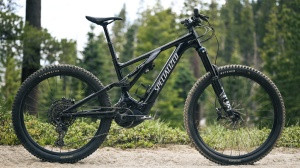 Specialized Turbo Levo Comp Alloy electric mountain bike showcasing its design
Specialized Turbo Levo Comp Alloy electric mountain bike showcasing its design
OVERALL SCORE: 87
- Downhill Performance: 9.0
- Climbing Performance: 8.0
- Measured Effective Range: 9.0
- Power Output: 9.0
- E-Bike Controls: 7.0
Wheel Size: MX (29″ front, 27.5″ rear) | Rear Travel: 150mm
REASONS TO BUY
- Powerful and responsive motor.
- Versatile and highly adjustable geometry.
- 700Wh battery offering great range.
REASONS TO AVOID
- Battery capacity is no longer leading the market.
- Lower-end models lack a digital display.
- Stock tires could benefit from tougher casing.
The Specialized Turbo Levo Comp Alloy remains a top recommended mountain bike in the e-MTB category, even after its last major update in 2022. Like the unpowered Stumpjumper, the Levo features highly adjustable geometry, allowing riders to customize its character for their riding style, terrain, and preferences. With six distinct geometry settings, it can be configured as a nimble trail bike, an aggressive gravity-oriented slayer, or anything in between. This unprecedented adjustability sets it apart in its class, significantly enhancing its versatility. It boasts 150mm of FSR rear wheel travel, a 160mm fork, and mixed wheel sizes for a confident front end and playful rear end. Specialized’s Turbo Full Power 2.2 motor is powerful, delivering 90Nm of torque and up to 565 peak watts, with three customizable pedal assist levels. A 700Wh battery is integrated into the downtube, providing substantial range, and the overall package is refined with balanced weight distribution for a natural ride feel.
The Comp Alloy is among the more affordable Turbo Levo builds, offering a functional component spec, though some areas could be improved. The SRAM Code R brakes are not our preferred choice, and the GRID TRAIL casing tires are not as robust as we’d like for a bike of this weight and capability. While the 700Wh battery is solid, competitors are increasing battery sizes, and we’d like to see compatibility with a range extender. Nevertheless, the Turbo Levo is one of the best and most well-rounded electric mountain bikes available. Its adjustable geometry elevates its versatility significantly. For riders prioritizing maximum range, the 900Wh battery of the Canyon Spectral:ON CF 8 may be a more suitable option.
Read more: Specialized Turbo Levo Comp Alloy Review
The Turbo Levo has been refined over the years, and its new adjustable geometry makes it a highly recommended electric mountain bike for its versatility.
Credit: Abriah Wofford
Best Electric Recommended Mountain Bike for Range
Canyon Spectral:ON CF 8
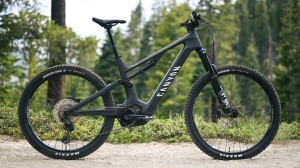 Canyon Spectral:ON CF 8 electric mountain bike highlighting its battery integration
Canyon Spectral:ON CF 8 electric mountain bike highlighting its battery integration
OVERALL SCORE: 85
- Downhill Performance: 8.0
- Climbing Performance: 8.0
- Measured Effective Range: 10.0
- Power Output: 8.0
- E-Bike Controls: 8.0
Wheel Size: MX (29″ front, 27.5″ rear) | Rear Travel: 155mm
REASONS TO BUY
- Comparatively reasonable price point.
- Great component build for the price.
- 900 Wh battery offers excellent range.
- Well-rounded trail riding performance.
REASONS TO AVOID
- Motor/battery bulge reduces ground clearance.
- Non-e-bike specific fork.
- Rear tire could be more robust.
Canyon’s updated Spectral:ON models, including the Canyon Spectral:ON CF 8, are versatile trail e-MTBs and represent excellent value, making them recommended mountain bikes for range. This carbon-framed bike features mixed wheels (29-inch front and 27.5-inch rear), 150/155mm of front/rear travel, and modern geometry well-suited for trail riding. Despite its 50+ pound weight, it handles well across varying speeds and terrain, offering a great balance of agility, stability, and composure. The popular Shimano EP8 motor delivers up to 85Nm of torque with customizable support settings. It also boasts a massive 900 Wh battery, providing the longest range of any electric mountain bike we’ve tested. Canyon’s direct-to-consumer sales model means this bike offers excellent value for the price, although still a significant investment. While not inexpensive, the Spectral:ON CF 8 is a fantastic value proposition. However, for those with a higher budget, the Turbo Levo Comp Alloy is also worth considering for its powerful motor and adjustable geometry.
Read more: Canyon Spectral:ON CF 8 Review
The Spectral:ON CF 8 offers well-rounded on-trail performance, a quality build, and a whopping 900 Wh battery at a comparatively reasonable price, making it a recommended mountain bike for extended range.
Credit: Abriah Wofford
Best Fat Recommended Bike
Fezzari Kings Peak Comp
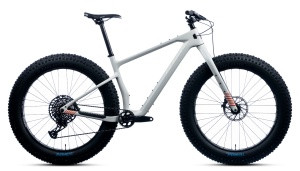 Fezzari Kings Peak Comp fat bike showcasing its robust tire and frame
Fezzari Kings Peak Comp fat bike showcasing its robust tire and frame
OVERALL SCORE: 81
- Downhill Performance: 8.0
- Uphill Performance: 8.0
- Versatility: 9.0
- Build Quality: 7.0
Tire Size: 27.5×4.5-inch | Fork Travel: N/A
REASONS TO BUY
- Reasonably priced for a fat bike.
- Modern trail-oriented geometry.
- Abundant frame and fork mounting points for accessories.
REASONS TO AVOID
- SRAM SX shifter ergonomics could be improved.
- Slip-on grips are a minor drawback.
Fezzari, a consumer-direct brand, is making a name for itself with quality bikes, including the Kings Peak Comp fat bike, a recommended mountain bike for fat bike enthusiasts. With geometry reminiscent of a regular trail bike, the longer and slacker Kings Peak feels familiar on snow and dirt. Fezzari’s 23-point custom setup ensures a comfortable fit, and the angles are well-suited for typical fat bike riding, yet surprisingly capable outside of normal fat bike terrain. With a sleek carbon frame and a weight of only 31 pounds, this bike pedals efficiently across various surfaces and looks great. The frame and fork offer numerous mounting points for water bottles and accessories, making it ideal for bike packing and adventure rides. The component build is functional and reliable. Fezzari also offers a higher-end build and component upgrades.
Aside from minor issues, we highly recommend the Kings Peak Comp. While we appreciate SRAM Eagle drivetrains, the SX version’s shifter ergonomics are not ideal. The slip-on grips can be easily replaced with lock-on grips. The Clarks M2 brakes are adequate for typical fat bike speeds, but long-term performance and durability are uncertain. Despite these minor points, the bike is excellent and earns our recommendation as the best fat recommended bike. If fat tires aren’t needed and you seek the best overall trail bike, consider the Ibis Ripmo V2 XT.
Read more: Fezzari Kings Peak Comp Review
The Fezzari Kings Peak has proven to be the best all-around fat recommended bike we’ve tested.
Credit: Jeremy Benson
How We Test Recommended Mountain Bikes
Our recommended mountain bike testing process focuses on identifying the best MTB bikes and rigorously testing them in real-world conditions. Our team of experienced testers pushes these bikes to their limits across diverse terrains. We conduct extensive bike park laps, all-day epic rides, significant climbs, and challenging descents. Our team has employed this rigorous testing methodology since 2017. We’ve tested a wide range of mountain bikes, including trail bikes, enduro bikes, hardtails, fat bikes, electric mountain bikes, and budget mountain bikes. Over the past seven years, we’ve invested over $200,000 purchasing mountain bikes for review to maintain objectivity and minimize bias. When we use media or demo bikes, we insist on paying demo or rental fees to uphold our autonomy and provide unbiased mountain bike recommendations.
Why Trust GearLab for Mountain Bike Recommendations
Our Senior Mountain Bike Review Editor, Joshua Hutchens, leads our expert test team. Joshua is a lifelong mountain biker, coach, former racer, guide, and shop owner with exceptional finesse and style. He has ridden hundreds of mountain bikes, allowing him to discern subtle performance differences.
For years, Joshua has collaborated with a diverse group of professional bike testers. Pat Donahue, former GearLab Mountain Bike Editor and current bike shop owner, is a talented rider with a preference for steep and technical descents. He is highly critical of gear and has a keen eye for performance characteristics that define a great bike. Kyle Smaine, raised near iconic trails, was a talented professional skier and multi-sport athlete with impressive mountain biking skills.
The Ripmo V2 is a favorite recommended mountain bike for good reason, excelling in all aspects of trail riding.
Credit: Laura Casner
How to Pick Your Recommended Mountain Bike
Purchasing a mountain bike is a significant investment requiring thorough research. Navigating the jargon and terminology, like mid-travel, short-travel, and enduro, can be confusing. OutdoorGearLab simplifies this process.
We explain different mountain bike types and their intended uses. Once you’ve chosen a category, consider wheel and tire size (29-inch, 27.5-inch, plus-sized), each with pros and cons. Female riders should decide between women’s-specific bikes or unisex bikes with fit adjustments. We guide you through these decisions to help you find your perfect recommended mountain bike.
Types of Recommended Mountain Bikes
Realistically assess your riding terrain to choose the right mountain bike type. Consider local trails and potential trips to bike parks or trail centers.
XC bikes are efficient and fast, suitable for long distances and cross-country riding, but may not be the best recommended mountain bike for all trail types.
Credit: Laura Casner
Cross-Country (XC) Bikes
Cross-country bikes are a niche category, primarily for racing, emphasizing weight and efficiency over comfort and versatility. XC bikes, either hardtails or with around 100mm of rear suspension, are stiff, efficient, and designed for speed on smoother trails. They feature steeper geometry, a low stem, and firm suspension.
While efficient on smooth trails, they are less playful and less capable on technical terrain with roots and rocks, unless you’re racing XC. A short-travel trail bike offers similar efficiency with greater versatility and fun, making it a more broadly recommended mountain bike for most riders.
Riding a bike is essential to understand its performance characteristics, informing our recommended mountain bike selections.
Credit: Jenna Ammerman
Trail Hardtails
Hardtail mountain bikes are excellent for general trail riding, prioritizing simplicity, low maintenance, and speed over tackling extremely steep or rough terrain. These no-frills bikes lack rear suspension but feature more aggressive trail geometry. They are efficient pedallers and capable of handling moderately technical trails. Less experienced riders can develop valuable skills on hardtails, which reward precise line choices and good form. While versatile, hardtails can be harsh on descents. Riders frequently tackling steep or rough terrain should consider full-suspension bikes.
Hardtails are generally more affordable than full-suspension bikes due to simpler technology, making them a great recommended mountain bike option for budget-conscious riders. Check our hardtail mountain bike reviews for more information.
Modern short-travel bikes are versatile and capable, often exceeding expectations for their travel, making them a recommended mountain bike choice for varied terrain.
Credit: Jenna Ammerman
Short-Travel Trail Bikes
Short-travel bikes (110-130mm rear travel) are excellent for riders who value versatility and efficient climbing without prioritizing extreme descending. They offer full-suspension comfort and confidence without sacrificing efficiency, suitable for long miles and flatter terrain or mountainous areas where aggressive descending isn’t the primary focus. For a better balance of climbing and descending, consider mid-travel bikes. If this balance suits your riding, explore 110-130mm options in our trail mountain bike reviews. These are recommended mountain bike types for riders seeking efficiency and comfort.
Mid-Travel Trail Bikes
Mid-travel bikes (130-150mm) are a versatile MTB sweet spot, ideal for riders who enjoy both climbing and descending. They balance climbing efficiency with descending capability, performing well across most trails, including occasional bike park visits and longer trail rides. This travel range suits a wide range of riders. In primarily flat or smooth areas, they might be overkill. For extreme downhill riding, enduro/long-travel bikes are more suitable. For a multi-faceted and fun category, explore our trail mountain bike reviews for 130-150mm options. Mid-travel bikes are widely recommended mountain bikes for their versatility.
Enduro bikes are designed for downhill performance and technical descents, recommended mountain bike for riders prioritizing aggressive downhill riding.
Credit: Jenna Ammerman
Enduro Bikes
Enduro bikes (150-170mm travel) are designed for technical descents, prioritizing downhill performance over climbing efficiency. They are excellent for aggressive descents, freeride lines, and bike parks, but less ideal for long-distance rides or climbing records. While they pedal reasonably well, efficiency isn’t their strength. For riders who prioritize downhill thrills and technical terrain, enduro bikes are a recommended mountain bike category.
27.5-inch and 29-inch wheels are now standard for most recommended mountain bikes, with 26-inch largely phased out.
Credit: Laura Casner
Choosing Bike Components for Your Recommended Mountain Bike
Once you’ve chosen a mountain bike type, component decisions further refine your selection.
Wheel Size
Mountain bike wheels have evolved from 26-inch to primarily 27.5-inch and 29-inch. Larger wheels roll over obstacles more efficiently, carry speed better, and improve momentum in rough terrain. Smaller wheels are more maneuverable and agile. 27.5-inch wheels were once considered a sweet spot, but modern 29er geometry has improved their handling, making them more playful. Mixed-wheel sizes (mullet or MX setup, 29-inch front, 27.5-inch rear) combine the benefits of both, offering stability and rollover with rear-end agility. Consider body size when choosing wheel size; smaller riders might prefer smaller wheels, and larger riders may prefer larger wheels. Many frames now offer wheel size options. Wheel size is a key consideration when selecting your recommended mountain bike.
Tires significantly impact bike performance; choosing the right tires is crucial for your recommended mountain bike. Maxxis Minion DHF is a tester favorite.
Credit: Jenna Ammerman
Tire Size and Rim Width
Tire widths have gradually increased. 2.35-inch was once standard, now 2.4-2.5-inch or even 2.6-inch are common on trail bikes. Wider tires offer more traction and a softer ride but may increase uphill resistance. Plus-sized or mid-fat tires (2.8-3-inch) offer even more traction. 2.8-inch tires provide a good balance of traction and cornering grip, while 3-inch tires offer maximum grip but potentially vague cornering. See our mountain bike tire reviews for more details.
Rims are also wider, with anything under 25mm now considered narrow for aggressive trail or enduro bikes. 28mm to 35mm rims are recommended mountain bike components, with 30mm being a sweet spot. Wider rims improve tire performance and traction. Check manufacturer recommendations for compatible tire ranges for your rims.
Most bikes are offered in various build kits and prices, allowing customization when choosing your recommended mountain bike.
Credit: Jenna Ammerman
Choosing a Complete Bike Build
-
Frame: Aluminum vs. Carbon. Aluminum frames are more affordable and heavier, while carbon fiber frames are lighter, stiffer, and better at dampening vibrations. Carbon fiber ages better and is a worthwhile investment for long-term ownership if budget allows when considering your recommended mountain bike.
-
Fork and Rear Shock: Higher-end suspension components offer greater adjustability and performance. Higher-end forks and shocks are more adjustable to rider weight and riding style. Heavier riders may prefer coil-sprung suspension over air shocks for durability and comfort. Suspension quality is crucial for a recommended mountain bike.
Most recommended mountain bikes now feature 1x drivetrains for simplicity and wide gear range.
Credit: Jenna Ammerman
-
Drivetrain: Most modern mountain bikes use 1x drivetrains (single chainring), which are simpler, easier to shift, and leave more handlebar space for dropper post controls. 1x drivetrains typically have 11 or 12 gears. 1x drivetrains are generally recommended mountain bike components for trail riding.
-
Wheelset: Higher quality wheelsets improve performance. Rim width is important for tire performance. Rims are available in aluminum and carbon fiber, with carbon fiber being more expensive. Wheelset quality is a significant factor in a recommended mountain bike.
Women’s specific bikes offer tailored components and shock tunes, important considerations for female riders seeking a recommended mountain bike.
Credit: Jenna Ammerman
Women’s Recommended Mountain Bikes
Most mountain bikes are unisex, but women’s-specific models address fit and performance differences. Unisex bikes are often designed for an average male rider, who is typically heavier and taller than the average female rider. Women’s-specific bikes often feature lighter shock tunes, women’s saddles, smaller grips, and sometimes shorter cranks and narrower handlebars. Brands like Juliana (Santa Cruz) and Liv (Giant) specialize in women’s bikes.
Frame sizing and shock tunes are critical for women’s recommended mountain bikes. Bikes need to fit properly, and suspension should respond to lighter riders. Many manufacturers now use lighter shock tunes on smaller bike sizes to better suit female riders.
Smaller bikes with lighter shock tunes are recommended mountain bike options for smaller riders, including women. Most mountain bikes are unisex and can work well for women with proper fit adjustments.
Credit: Jenna Ammerman
Consumer Direct vs. Local Bike Shop for Your Recommended Mountain Bike
Consumer-direct brands sell bikes online, often at lower prices by cutting out bike shops. Brands like YT, Commencal, and Canyon are major consumer-direct brands.
Consumer-direct offers convenience and savings, but buying from a local bike shop provides a relationship with the shop, potential complimentary services, quicker repairs, warranty service, and expert advice. Local bike shops are valuable resources for knowledge and spotting potential issues. Consider these factors when choosing where to purchase your recommended mountain bike.
Consumer-direct bikes require minimal assembly, offering convenience when purchasing your recommended mountain bike.
Credit: Jenna Ammerman
Multiple Bikes?
Having a quiver of mountain bikes is ideal but expensive. A short-travel bike and an enduro bike cover most trails. Mid-travel trail bikes are often the best compromise, versatile for various terrains. For occasional bike park trips, renting a longer travel bike is an option. Mid-travel bikes are often the most recommended mountain bike type for overall versatility.
More bikes mean more specialized capabilities but also more maintenance, a consideration for riders building a quiver of recommended mountain bikes.
Credit: Jenna Ammerman
Trainers, Exercise Bikes, and the Off-Season
For off-season training or when trails aren’t accessible, home training options include exercise bikes and bike trainers. Interactive exercise bikes and bike trainers offer virtual riding experiences and training programs. Treadmills are another option for off-season fitness. These are helpful for maintaining fitness when you can’t ride your recommended mountain bike on trails.
Numerous great mountain bikes are available; choose a recommended mountain bike and start riding.
Credit: Laura Casner
Conclusion: Finding Your Recommended Mountain Bike
This guide aims to simplify your mountain bike buying decision. Consider your skills, goals, and riding terrain. The bikes listed are among the best available. OutdoorGearLab continuously tests and reviews top bikes to keep this list current, helping you find your perfect recommended mountain bike.

 Mountain biker skillfully navigating a technical uphill climb on the Ibis Ripmo V2, showcasing its climbing capabilities
Mountain biker skillfully navigating a technical uphill climb on the Ibis Ripmo V2, showcasing its climbing capabilities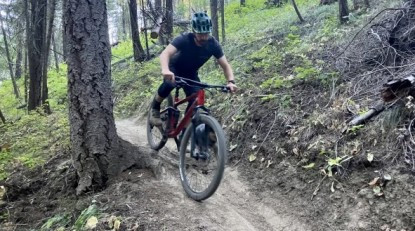 Mountain biker confidently descending a trail on the Norco Fluid 4 FS, highlighting its downhill capabilities
Mountain biker confidently descending a trail on the Norco Fluid 4 FS, highlighting its downhill capabilities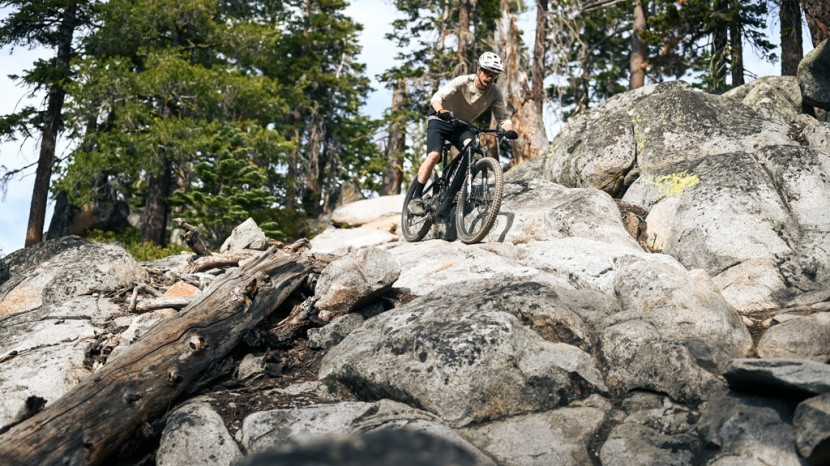 Mountain biker riding the Specialized Turbo Levo, demonstrating its refined design and adjustable geometry
Mountain biker riding the Specialized Turbo Levo, demonstrating its refined design and adjustable geometry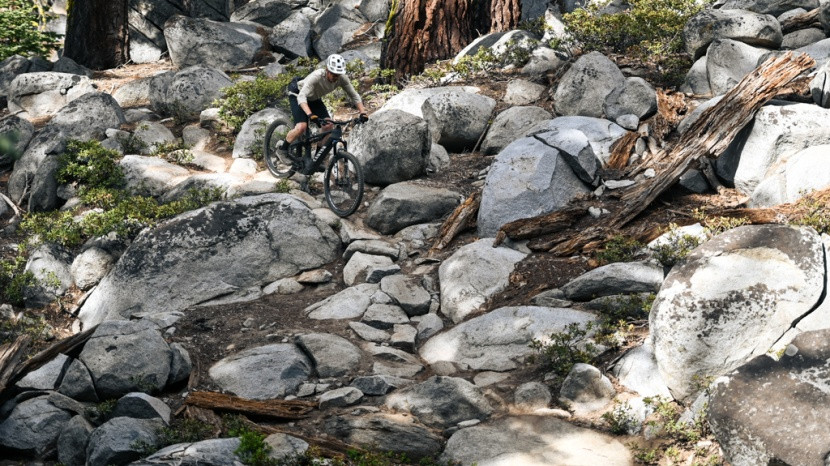 Mountain biker riding the Canyon Spectral:ON CF 8, demonstrating its on-trail performance and long-range capability
Mountain biker riding the Canyon Spectral:ON CF 8, demonstrating its on-trail performance and long-range capability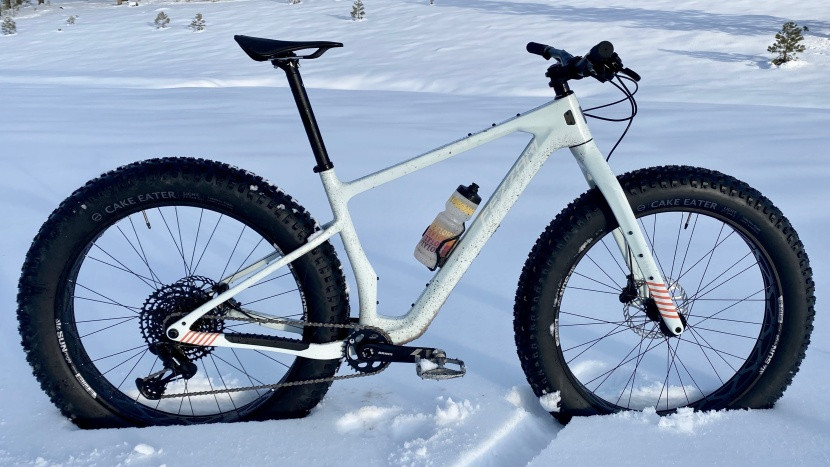 Mountain biker riding the Fezzari Kings Peak fat bike, demonstrating its all-around capabilities in fat bike conditions
Mountain biker riding the Fezzari Kings Peak fat bike, demonstrating its all-around capabilities in fat bike conditions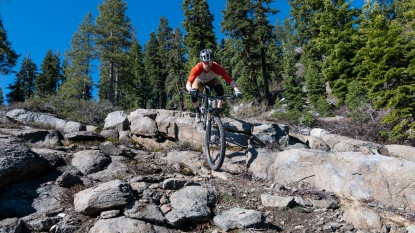 Mountain biker riding the Ibis Ripmo V2, emphasizing its well-rounded performance and status as a favorite recommended mountain bike
Mountain biker riding the Ibis Ripmo V2, emphasizing its well-rounded performance and status as a favorite recommended mountain bike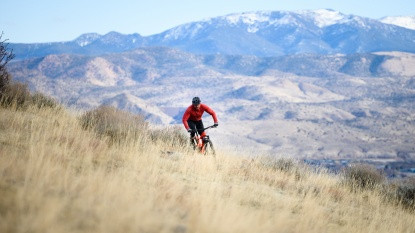 Mountain biker on an XC bike, highlighting its efficiency and speed for long distances and cross-country terrain
Mountain biker on an XC bike, highlighting its efficiency and speed for long distances and cross-country terrain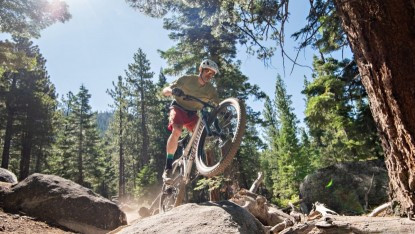 Mountain biker testing a bike, emphasizing the importance of riding to understand its performance for making informed recommendations
Mountain biker testing a bike, emphasizing the importance of riding to understand its performance for making informed recommendations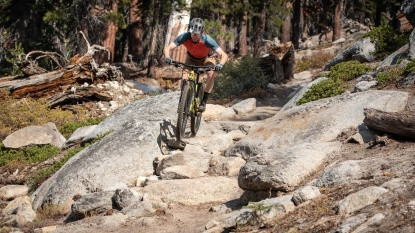 Mountain biker riding a modern short-travel bike, highlighting its versatility and capabilities beyond its travel numbers, making it a recommended mountain bike type
Mountain biker riding a modern short-travel bike, highlighting its versatility and capabilities beyond its travel numbers, making it a recommended mountain bike type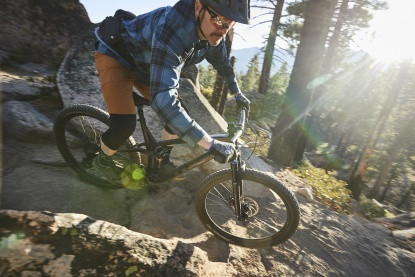 Mountain biker on a trail, representing mid-travel bikes as a versatile and recommended mountain bike category
Mountain biker on a trail, representing mid-travel bikes as a versatile and recommended mountain bike category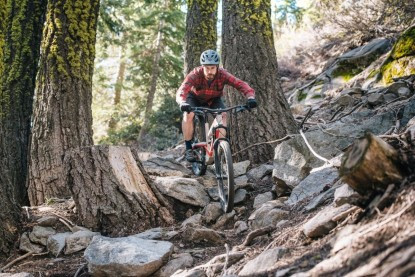 Mountain biker riding an enduro bike, emphasizing their downhill focus and suitability for aggressive terrain as a recommended mountain bike type
Mountain biker riding an enduro bike, emphasizing their downhill focus and suitability for aggressive terrain as a recommended mountain bike type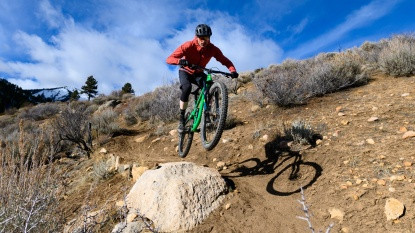 Mountain bike wheels, highlighting the shift from 26-inch to 27.5-inch and 29-inch as standard sizes for recommended mountain bikes
Mountain bike wheels, highlighting the shift from 26-inch to 27.5-inch and 29-inch as standard sizes for recommended mountain bikes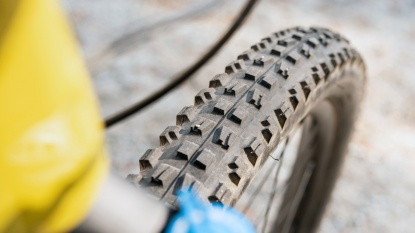 Mountain bike tires, emphasizing the importance of tire choice for performance in recommended mountain bike selection
Mountain bike tires, emphasizing the importance of tire choice for performance in recommended mountain bike selection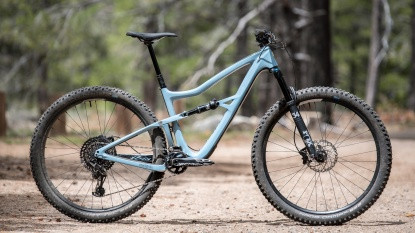 Mountain bike build kits, showing the range of component options and prices for recommended mountain bikes
Mountain bike build kits, showing the range of component options and prices for recommended mountain bikes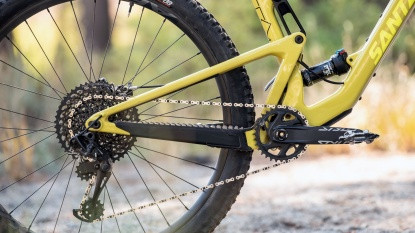 Mountain bike drivetrain, highlighting the shift to 1x drivetrains for simplicity and performance in modern recommended mountain bikes
Mountain bike drivetrain, highlighting the shift to 1x drivetrains for simplicity and performance in modern recommended mountain bikes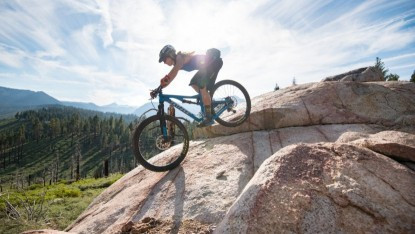 Women's specific mountain bikes, discussing adjustments for female riders in recommended mountain bike selection
Women's specific mountain bikes, discussing adjustments for female riders in recommended mountain bike selection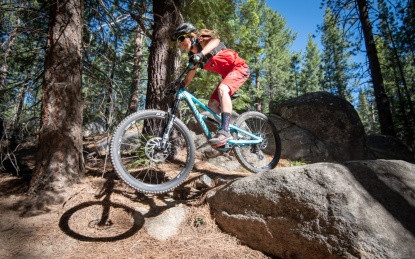 Mountain bikes with lighter shock tunes for smaller riders, addressing fit for women's recommended mountain bikes
Mountain bikes with lighter shock tunes for smaller riders, addressing fit for women's recommended mountain bikes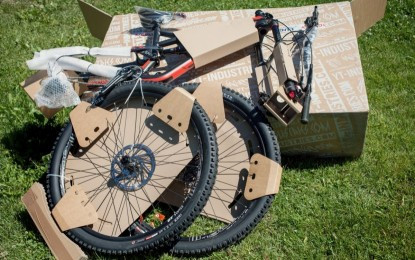 Mountain bike minimal assembly, highlighting consumer-direct bike convenience when purchasing your recommended mountain bike
Mountain bike minimal assembly, highlighting consumer-direct bike convenience when purchasing your recommended mountain bike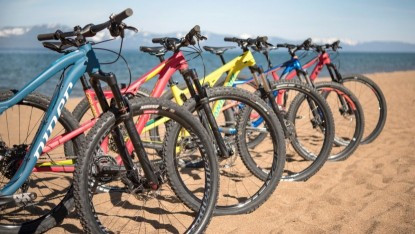 Mountain bikes in a quiver, discussing the benefits and considerations of owning multiple bikes for different riding styles and terrain for recommended mountain bike users
Mountain bikes in a quiver, discussing the benefits and considerations of owning multiple bikes for different riding styles and terrain for recommended mountain bike users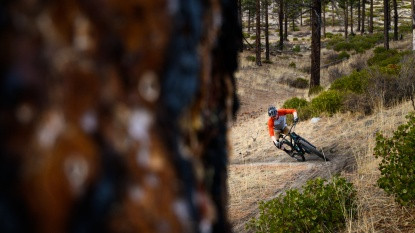 Mountain bikes with diverse options, encouraging readers to choose a bike and start riding from recommended mountain bike selection
Mountain bikes with diverse options, encouraging readers to choose a bike and start riding from recommended mountain bike selection